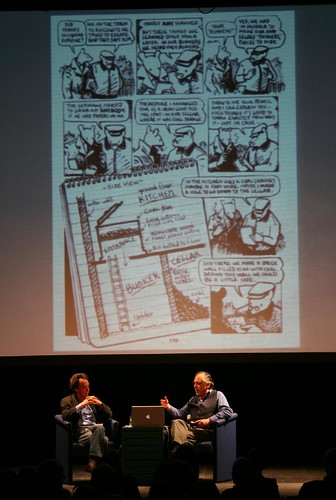
Art Spiegelman was here Friday night and I didn’t even hear about it.
How the hell did that happen?
I mean, I’m a cartoonist, and I live in Cleveland. How did I not hear about one of our greatest living cartoonists visiting Cleveland?
Dang! Dang, dang, dang!
I’m really upset. Where was the publicity?
Kim Yanoshik has a little write-up here, along with some pretty good photos, like the one above.
If anybody else was there, I’d like to hear about it.
Publicity in this town blows. I missed A. S. Byatt last year because nobody thought to, like, tell anybody else she was going to be here, or something.
bah!
Cleveland Public Library and Cleveland Public Art…thought you might have been there…seen it for weeks through my contacts…
i guess i just had my head in the sand
ok, I really had NO excuse to miss this, considering my pal Lee did a whole writeup on the thing:
Comix 101 @ CPT 5/18
http://www.coolcleveland.com
By Lee Chilcote
Simpsons, eat your heart out.
Comics legend Art Spiegelman and New York Times art critic Michael Kimmelman spoke, and at time sparred, over comics as an art form, Mad Magazine and the Jewish-ness of comics before a packed audience at Cleveland Public Theater on Friday night. The two writers were brought to town by Cleveland Public Art and the Cleveland Public Library as a part of the Robert Lockwood-Thompson series.
Spiegelman, whose groundbreaking comics in the 60s/70s paved the way for South Park, Simpsons and trendy graphic novels, chain-smoked on stage and giddily clicked through slides of his work as he spoke. (The plumes of smoke emanating from the stage seemed gloriously taboo in our present, smoke-free state – lending a further air of rebellion to the countercultural artist.)
Kimmelman struggled to interject as Spiegelman – annoyed, seemingly, at attempts to lift his work from the page and offer interpretation other than his own – steamrolled over him. Renowned for his writing in the Times, several books of art criticism, and efforts to make writing on art accessible, Kimmelman was nonetheless no match for the soliloquizing tour de force that is Art Spiegelman.
Explaining his rationale towards comics as an outsider art form, Spiegelman commented, “Comics don’t have to be paintings to be art. They have their own logic system. When people think of comics they think of superheroes, but I’m interested in satire. I always liked Mad Magazine because it’s iconoclastic.???
He also described comics as a “mongrel art form??? because they are “a blend of poetry and image … They present things in a way that’s similar to how we think and use language – in short bursts.??? He added, “People don’t think in long narratives or iconic images, which is what novels and paintings are.???
Spiegelman’s varied career included the creation of the underground comics anthology “RAW,??? co-creation of the 80s novelties “Garbage Pail Kids???
and “Wacky Packages??? (he parted ways with Topps Bubble Gum twenty years after his first assignment, citing a dispute over their paltry pay), and a decade of covers for the New Yorker. Spiegelman’s most famous book, “Maus,??? is a story about his father’s experiences as a Holocaust survivor during World War II. Among other things, the book poignantly characterizes the relationship between a Holocaust survivor and his son, reflecting in its own, multi-tiered narrative the way in which Vladik Spiegelman’s haunted history suffuses his son’s memory and personal story, ultimately impacting and influencing his art as well.
The evening was a kind of history lesson, as well, on the evolution of comics from the pulp rack, to galleries and museums. Spiegelman won a Pulitzer for “Maus??? in 1992, around the time that the Museum of Modern Art (MOMA) in New York staged an exhibition about his work. “When the idea of creating a prints department at MOMA was first discussed, there was a curator there that said, ‘Over my dead body’,??? Spiegelman said dryly. “Well, he’s dead now.???
Spiegelman also discussed his own struggle to push comics in new directions without making his work inaccessible or effete. “The deconstructionist stuff, if that’s what you call it, reaches smaller audiences,??? he said. “People want stories.???
Spiegelman’s spiel winded down as he talked about his own influences, particularly Mad Magazine. The magazine, which was the target of a Congressional inquiry into causes of juvenile delinquency in the 1950s, “changed my life,??? Spiegelman said. “It acknowledged that we live in a mediated world, while also acknowledging that it too was a part of the media.
The ironic distance of the Simpsons started with Mad Magazine.???
Asked a question about whether he prefers the term “comics??? or “graphic novels,??? Spiegelman, true to form, voted for none of the above. The term graphic novel is “an attempt to earn respectability??? for the genre, he said.
He himself prefers the term “comix,??? which he claims can be taken to refer to the “co-mixing??? of art forms – visual art and poetry –taking place within the genre.
From Cool Cleveland contributor Lee Chilcote leechilcoteATgmail.com